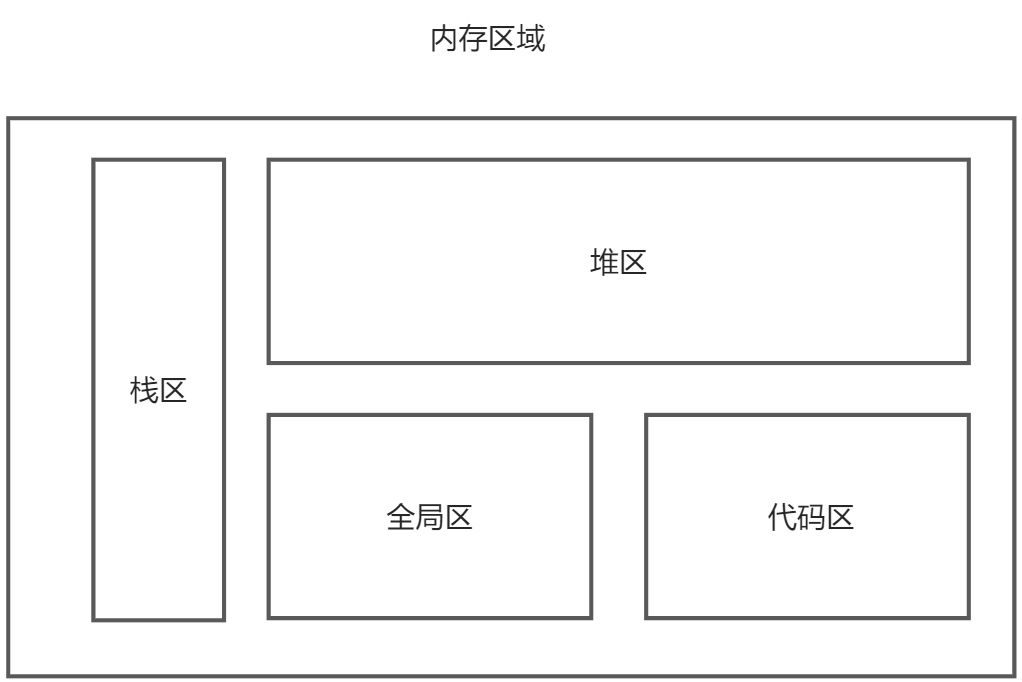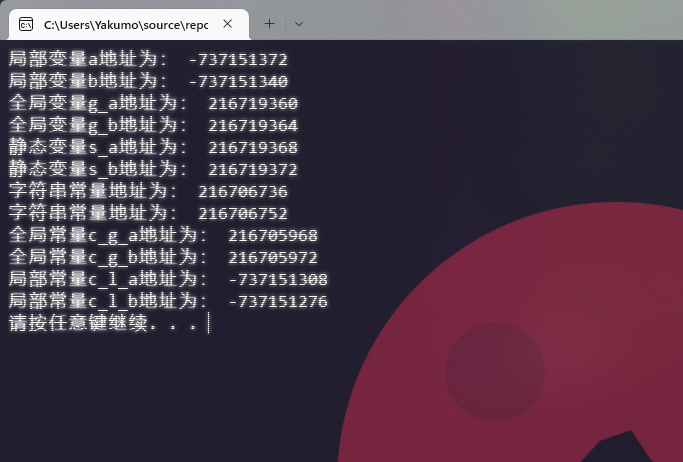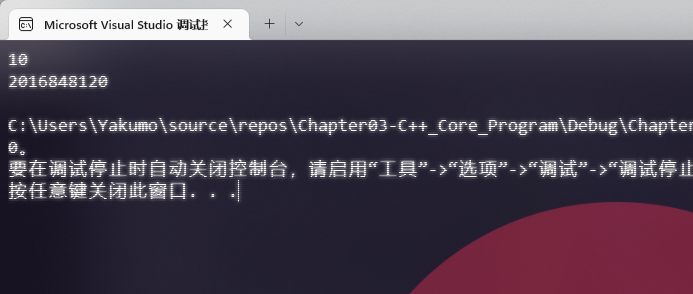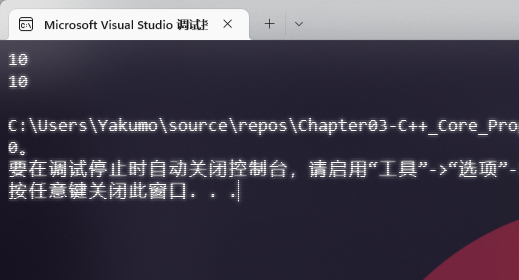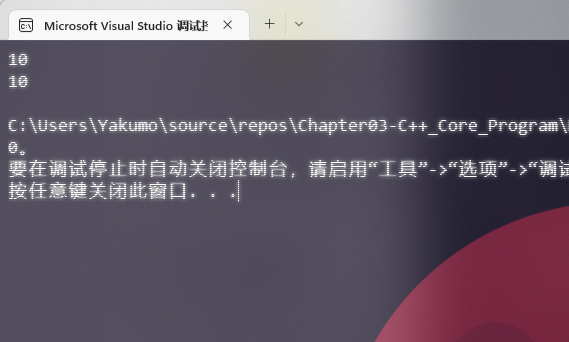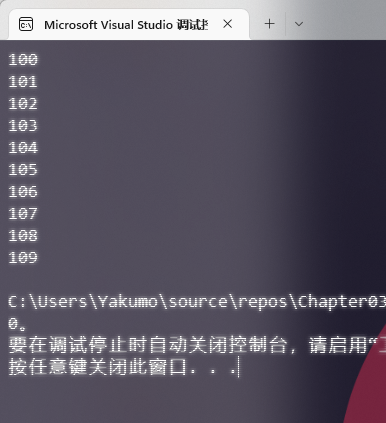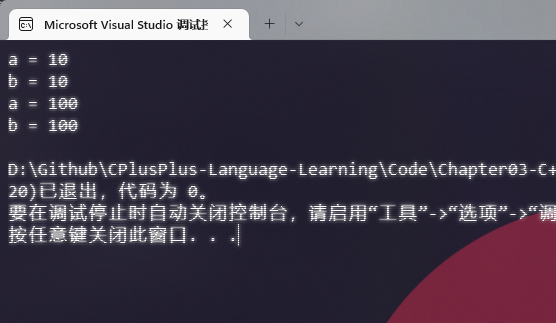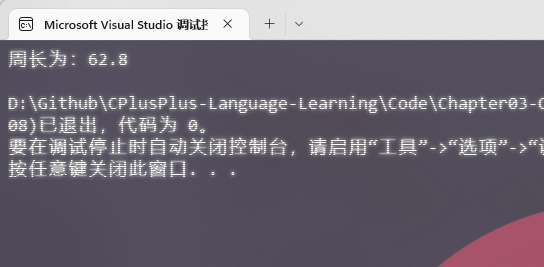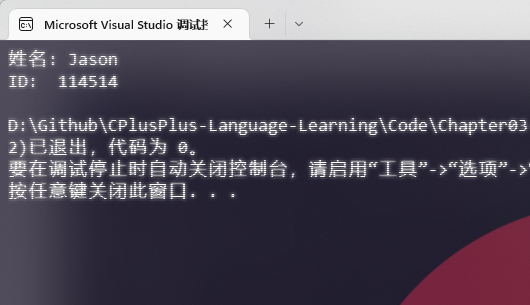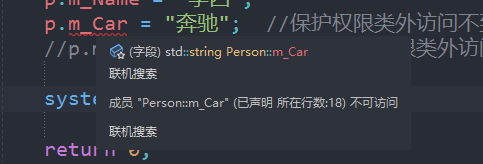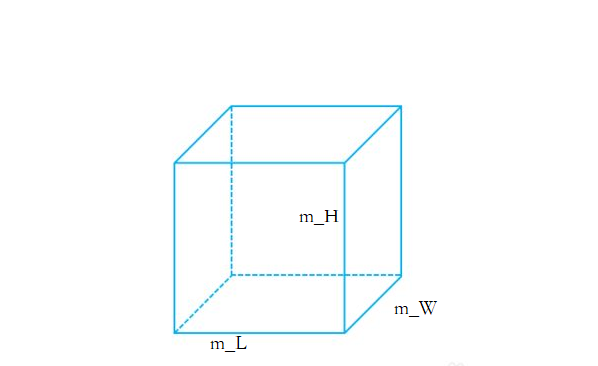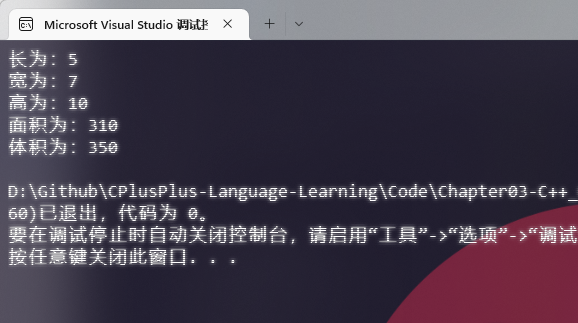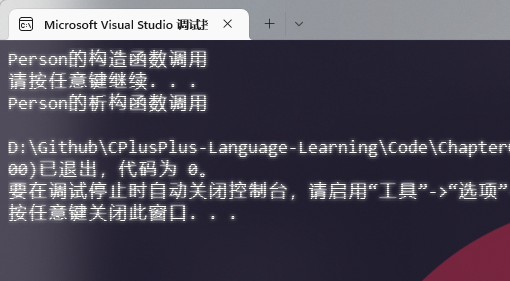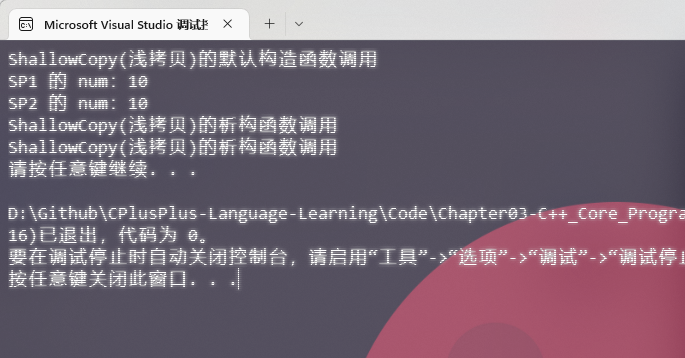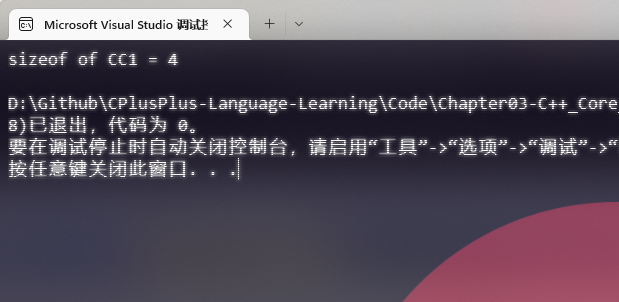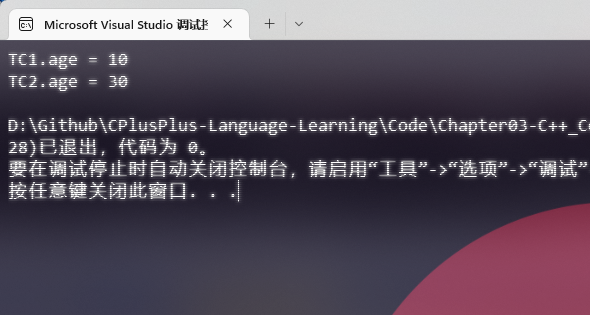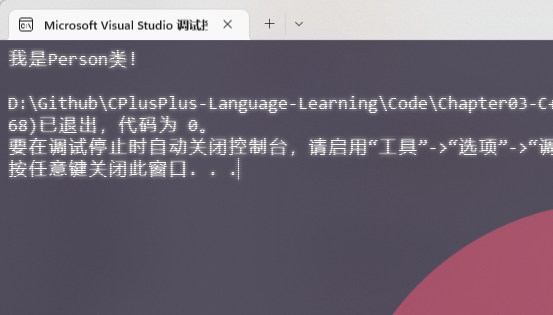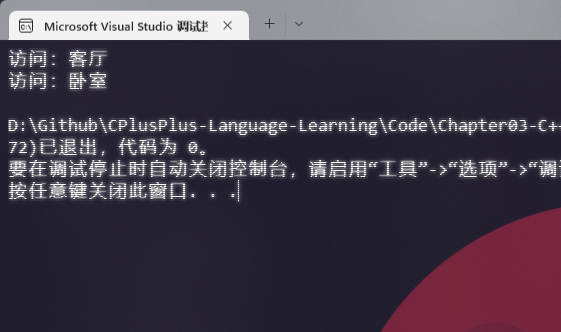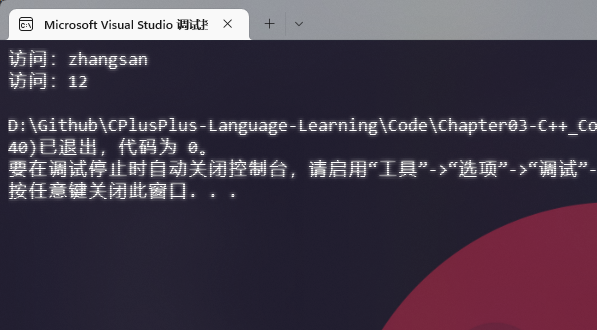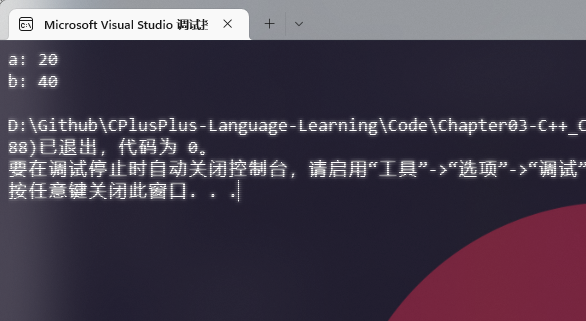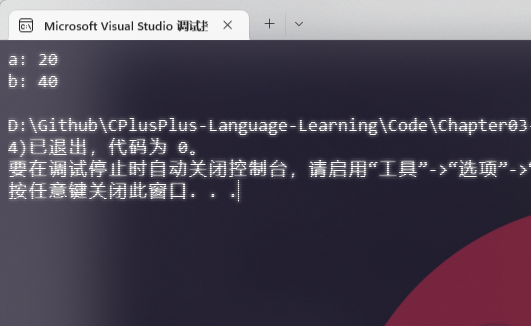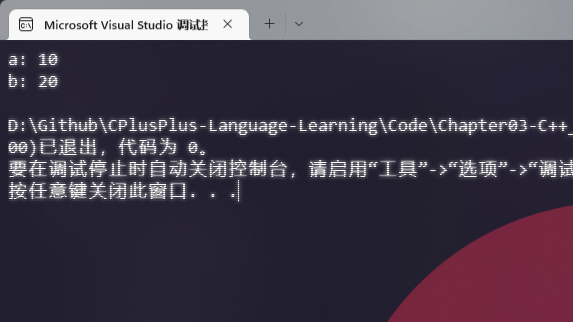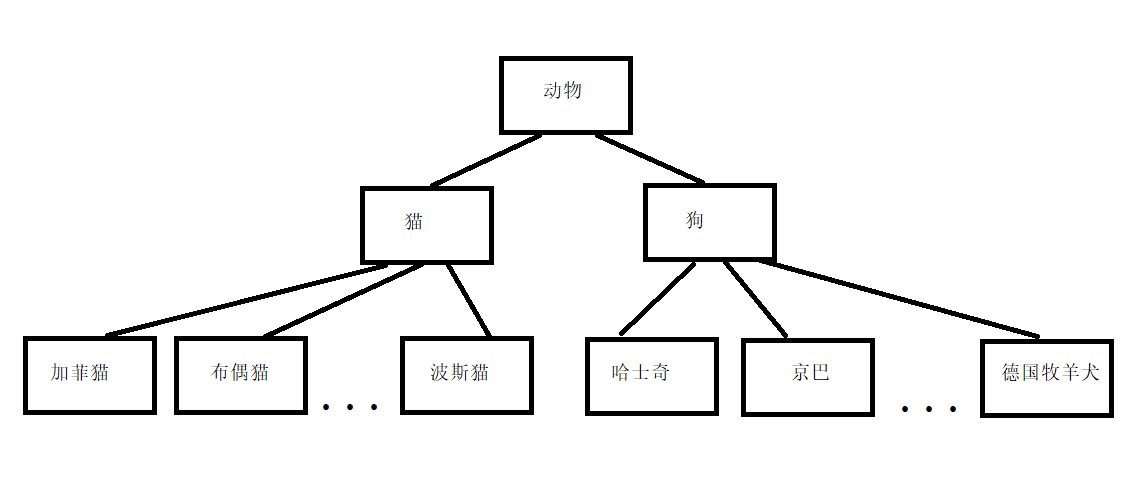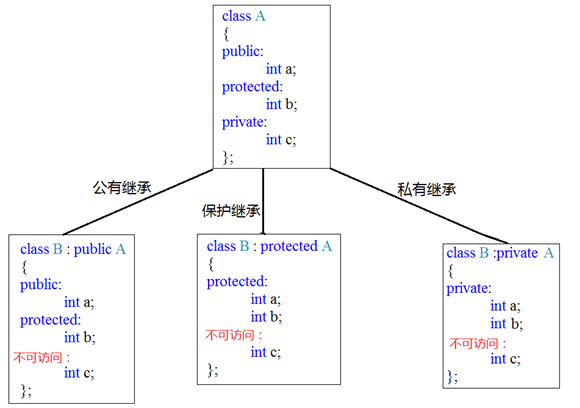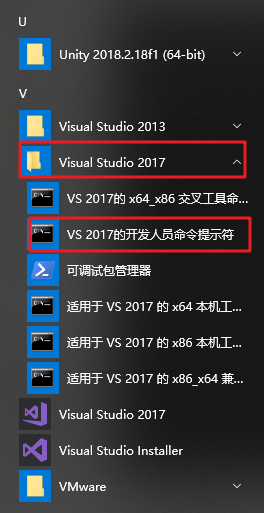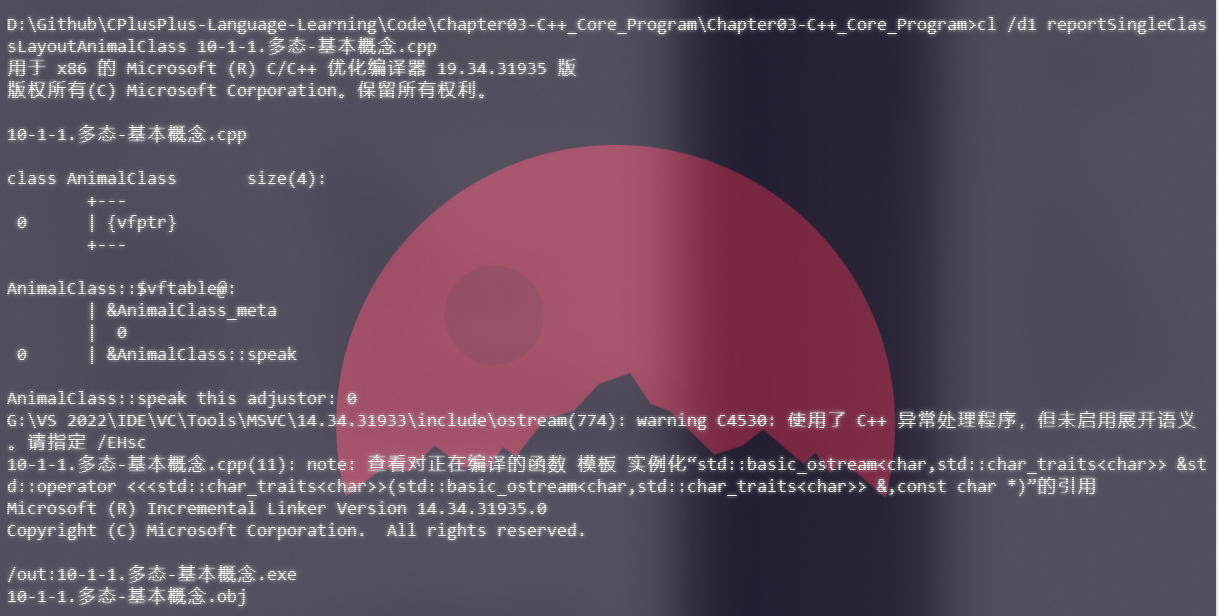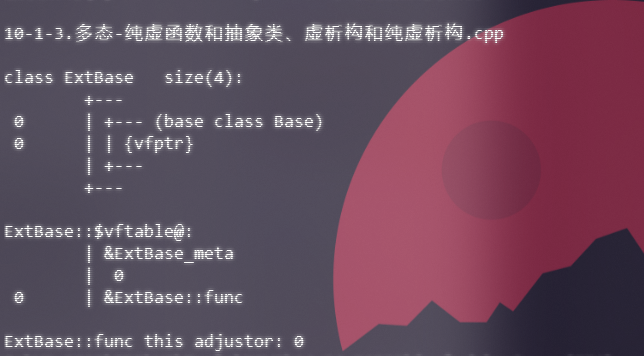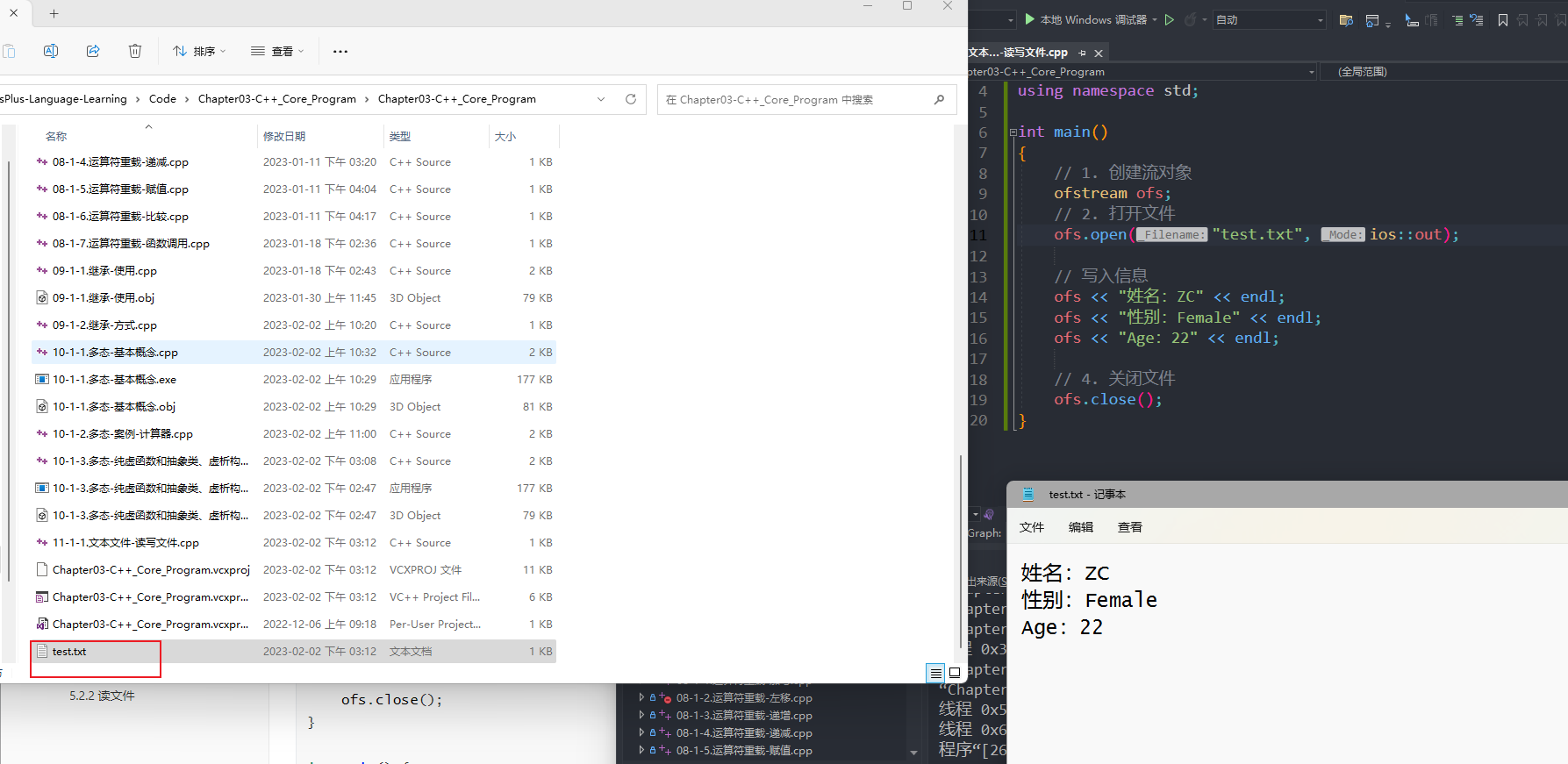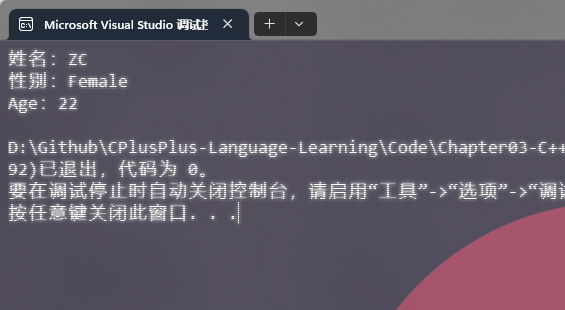内存分区模型
引用
函数提高
类和对象
文件操作
内存分区模型 C++程序在执行时,将内存大方向划分为4个区域
代码区:存放函数体的二进制代码,由操作系统进行管理的
全局区:存放全局变量和静态变量以及常量
栈区:由编译器自动分配释放, 存放函数的参数值,局部变量等
堆区:由程序员分配和释放,若程序员不释放,程序结束时由操作系统回收
内存四区意义:
不同区域存放的数据,赋予不同的生命周期, 给我们更大的灵活编程
1.1 程序运行前 在程序编译后,生成了exe可执行程序,未执行该程序前 分为两个区域
代码区:
存放 CPU 执行的机器指令
代码区是共享 的,共享的目的是对于频繁被执行的程序,只需要在内存中有一份代码即可
代码区是只读 的,使其只读的原因是防止程序意外地修改了它的指令
全局区:
全局变量和静态变量存放在此.
全局区还包含了常量区, 字符串常量和其他常量也存放在此.
==该区域的数据在程序结束后由操作系统释放==.
1 2 3 4 5 6 7 8 9 10 11 12 13 14 15 16 17 18 19 20 21 22 23 24 25 26 27 28 29 30 31 32 33 34 35 36 37 38 39 40 41 42 43 44 45 46 47 #define _CRT_SECURE_NO_WARNINGS 1 #include <iostream> using namespace std;int g_a = 10 ;int g_b = 10 ;const int c_g_a = 10 ;const int c_g_b = 10 ;int main () int a = 10 ;int b = 10 ;"局部变量a地址为: " << (int )&a << endl;"局部变量b地址为: " << (int )&b << endl;"全局变量g_a地址为: " << (int )&g_a << endl;"全局变量g_b地址为: " << (int )&g_b << endl;static int s_a = 10 ;static int s_b = 10 ;"静态变量s_a地址为: " << (int )&s_a << endl;"静态变量s_b地址为: " << (int )&s_b << endl;"字符串常量地址为: " << (int )&"hello world" << endl;"字符串常量地址为: " << (int )&"hello world1" << endl;"全局常量c_g_a地址为: " << (int )&c_g_a << endl;"全局常量c_g_b地址为: " << (int )&c_g_b << endl;const int c_l_a = 10 ;const int c_l_b = 10 ;"局部常量c_l_a地址为: " << (int )&c_l_a << endl;"局部常量c_l_b地址为: " << (int )&c_l_b << endl;system ("pause" );return 0 ;
总结:
C++中在程序运行前分为全局区和代码区
代码区特点是共享和只读
全局区中存放全局变量、静态变量、常量
常量区中存放 const修饰的全局常量 和 字符串常量
1.2 程序运行后 栈区:
由编译器自动分配释放, 存放函数的参数值,局部变量等
注意事项:不要返回局部变量的地址,栈区开辟的数据由编译器自动释放
1 2 3 4 5 6 7 8 9 10 11 12 13 14 15 16 17 18 19 #define _CRT_SECURE_NO_WARNINGS 1 #include <iostream> using namespace std;int * func () int a = 10 ; return &a;int main () int * p = func ();return 0 ;
堆区:
由程序员分配释放,若程序员不释放,程序结束时由操作系统回收
在C++中主要利用new在堆区开辟内存
1 2 3 4 5 6 7 8 9 10 11 12 13 14 15 16 17 18 19 #define _CRT_SECURE_NO_WARNINGS 1 #include <iostream> using namespace std;int * func () int * a = new int (10 );return a;int main () int * p = func ();return 0 ;
总结:
堆区数据由程序员管理开辟和释放
堆区数据利用new关键字进行开辟内存
1.3 new操作符 C++中利用==new==操作符在堆区开辟数据
堆区开辟的数据,由程序员手动开辟,手动释放,释放利用操作符 ==delete==
语法: new 数据类型
利用new创建的数据,会返回该数据对应的类型的指针
基本使用:
1 2 3 4 5 6 7 8 9 10 11 12 13 14 15 16 17 18 19 20 21 22 23 24 #define _CRT_SECURE_NO_WARNINGS 1 #include <iostream> using namespace std;int * func3 () int * a = new int (10 );return a;int main () int * p = func3 ();delete p;return 0 ;
开辟数组:
1 2 3 4 5 6 7 8 9 10 11 12 13 14 15 16 17 18 19 20 21 22 23 #define _CRT_SECURE_NO_WARNINGS 1 #include <iostream> using namespace std;int main () int * arr = new int [10 ];int i = 0 ;for (i = 0 ; i < 10 ; i++)100 ;for (i = 0 ; i < 10 ; i++)delete [] arr;return 0 ;
引用 基本使用 **作用: **给变量起别名
语法: 数据类型 &别名 = 原名
1 2 3 4 5 6 7 8 9 10 11 12 13 14 15 16 17 18 19 #define _CRT_SECURE_NO_WARNINGS 1 #include <iostream> using namespace std;int main () int a = 10 ;int & b = a;"a = " << a << endl;"b = " << b << endl;100 ;"a = " << a << endl;"b = " << b << endl;return 0 ;
注意事项
1 2 3 4 5 6 7 8 9 10 11 12 13 14 15 16 17 18 19 20 #define _CRT_SECURE_NO_WARNINGS 1 #include <iostream> using namespace std;int main () int a = 10 ;int b = 20 ;int &c = a; "a = " << a << endl;"b = " << b << endl;"c = " << c << endl;system ("pause" );return 0 ;
做函数参数 作用: 函数传参时,可以利用引用的技术让形参修饰实参
优点: 可以简化指针修改实参
1 2 3 4 5 6 7 8 9 10 11 12 13 14 15 16 17 18 19 20 21 22 23 24 25 26 27 28 29 30 31 32 33 34 35 36 37 38 39 40 41 42 #define _CRT_SECURE_NO_WARNINGS 1 #include <iostream> using namespace std;void mySwap01 (int a, int b) int temp = a;void mySwap02 (int * a, int * b) int temp = *a;void mySwap03 (int & a, int & b) int temp = a;int main () int a = 10 ;int b = 20 ;mySwap01 (a, b);"a:" << a << " b:" << b << endl;mySwap02 (&a, &b);"a:" << a << " b:" << b << endl;mySwap03 (a, b);"a:" << a << " b:" << b << endl;return 0 ;
总结:通过引用参数产生的效果同按地址传递是一样的。引用的语法更清楚简单
做函数返回值 作用:引用是可以作为函数的返回值存在的
注意:不要返回局部变量引用
用法:函数调用作为左值
1 2 3 4 5 6 7 8 9 10 11 12 13 14 15 16 17 18 19 20 21 22 23 24 25 26 27 28 29 30 31 int & test01 () int a = 10 ; return a;int & test02 () static int a = 20 ;return a;int main () int & ref = test01 ();"ref = " << ref << endl;"ref = " << ref << endl;int & ref2 = test02 ();"ref2 = " << ref2 << endl;"ref2 = " << ref2 << endl;test02 () = 1000 ;"ref2 = " << ref2 << endl;"ref2 = " << ref2 << endl;return 0 ;
本质 1 2 3 4 5 6 7 8 9 10 11 12 13 14 15 16 17 void func (int & ref) 100 ; int main () int a = 10 ;int & ref = a; 20 ; "a:" << a << endl;"ref:" << ref << endl;func (a);return 0 ;
结论:C++推荐用引用技术,因为语法方便,引用本质是指针常量,但是所有的指针操作编译器都帮我们做了
常量引用 作用: 常量引用主要用来修饰形参,防止误操作
在函数形参列表中,可以加==const修饰形参==,防止形参改变实参
1 2 3 4 5 6 7 8 9 10 11 12 13 14 15 16 17 18 19 20 21 22 23 void showValue (const int & v) int main () const int & ref = 10 ;int a = 10 ;showValue (a);system ("pause" );return 0 ;
函数提高 默认参数 在C++中,函数的形参列表中的形参是可以有默认值的。
语法: 返回值类型 函数名 (参数= 默认值){}
1 2 3 4 5 6 7 8 9 10 11 12 13 14 15 16 17 18 19 20 21 22 #define _CRT_SECURE_NO_WARNINGS 1 #include <iostream> using namespace std;int func (int a, int b = 10 , int c = 10 ) return a + b + c;int func2 (int a = 10 , int b = 10 ) int func2 (int a, int b) return a + b;int main () "ret = " << func (20 , 20 ) << endl;"ret = " << func (100 ) << endl;return 0 ;
占位参数 C++中函数的形参列表里可以有占位参数,用来做占位,调用函数时必须填补该位置
语法: 返回值类型 函数名 (数据类型){}
1 2 3 4 5 6 7 8 9 10 11 12 13 14 15 #define _CRT_SECURE_NO_WARNINGS 1 #include <iostream> using namespace std;void func (int a, int ) "this is func" << endl;int main () func (10 ,10 ); return 0 ;
函数重载 概述 作用: 函数名可以相同,提高复用性
函数重载满足条件:
同一个作用域下
函数名称相同
函数参数类型不同 或者 个数不同 或者 顺序不同
注意: 函数的返回值不可以作为函数重载的条件
1 2 3 4 5 6 7 8 9 10 11 12 13 14 15 16 17 18 19 20 21 22 23 24 25 26 27 28 29 30 31 32 33 34 35 36 37 38 39 40 void func () "func 的调用!" << endl;void func (int a) "func (int a) 的调用!" << endl;void func (double a) "func (double a)的调用!" << endl;void func (int a ,double b) "func (int a ,double b) 的调用!" << endl;void func (double a ,int b) "func (double a ,int b)的调用!" << endl;int main () func ();func (10 );func (3.14 );func (10 ,3.14 );func (3.14 , 10 );system ("pause" );return 0 ;
注意事项
1 2 3 4 5 6 7 8 9 10 11 12 13 14 15 16 17 18 19 20 21 22 23 24 25 26 27 28 29 30 31 32 33 34 35 36 37 38 39 void func (int &a) "func (int &a) 调用 " << endl;void func (const int &a) "func (const int &a) 调用 " << endl;void func2 (int a, int b = 10 ) "func2(int a, int b = 10) 调用" << endl;void func2 (int a) "func2(int a) 调用" << endl;int main () int a = 10 ;func (a); func (10 );system ("pause" );return 0 ;
类和对象 C++面向对象的三大特性为:==封装、继承、多态==
人可以作为对象,属性有姓名、年龄、身高、体重…,行为有走、跑、跳、吃饭、唱歌…
车也可以作为对象,属性有轮胎、方向盘、车灯…,行为有载人、放音乐、放空调…
具有相同性质的==对象==,我们可以抽象称为==类==,人属于人类,车属于车类
封装 概念 在设计类的时候,属性和行为写在一起,表现事物
语法: class 类名{ 访问权限: 属性 / 行为 };
1 2 3 4 5 6 7 8 9 10 11 12 13 14 15 16 17 18 19 20 21 22 23 24 25 26 27 28 29 30 31 32 33 34 35 36 37 38 39 40 41 42 43 #define _CRT_SECURE_NO_WARNINGS 1 #include <iostream> using namespace std;const double PI = 3.14 ;class Circle public : int m_r;double calculateZC () {return 2 * PI * m_r;int main () 10 ; "圆的周长为: " << c1.calculateZC () << endl;system ("pause" );return 0 ;
设计一个学生类,属性有姓名和学号,可以给姓名和学号赋值,可以显示学生的姓名和学号
1 2 3 4 5 6 7 8 9 10 11 12 13 14 15 16 17 18 19 20 21 22 23 24 25 26 27 28 29 30 31 32 33 34 35 36 37 38 39 40 41 #define _CRT_SECURE_NO_WARNINGS 1 #include <iostream> #include <string> using namespace std;class Student public :int ID; public :void setName (string name) {void setID (int id) {void showStu () {"姓名: " << stu_name << endl;"ID: " << ID << endl;int main () setName ("Jason" );setID (114514 );showStu ();return 0 ;
封装意义二:
类在设计时,可以把属性和行为放在不同的权限下,加以控制
访问权限有三种:
public 公共权限
protected 保护权限
private 私有权限
1 2 3 4 5 6 7 8 9 10 11 12 13 14 15 16 17 18 19 20 21 22 23 24 25 26 27 28 29 30 31 32 33 34 35 36 37 38 39 40 41 42 43 #define _CRT_SECURE_NO_WARNINGS 1 #include <iostream> #include <string> using namespace std;class Person public :protected :private :int m_Password;public :void func () {"张三" ;"拖拉机" ;123456 ;int main () "李四" ;system ("pause" );return 0 ;
struct 和 class 区别在C++中 struct和class唯一的区别 就在于 默认的访问权限不同
区别:
struct 默认权限为公共
class 默认权限为私有
1 2 3 4 5 6 7 8 9 10 11 12 13 14 15 16 17 18 19 20 21 22 23 24 25 #define _CRT_SECURE_NO_WARNINGS 1 #include <iostream> using namespace std;struct S1 int m_A; class C1 int m_A; int main () 10 ; return 0 ;
成员属性设置为私有 优点1: 将所有成员属性设置为私有,可以自己控制读写权限
优点2: 对于写权限,我们可以检测数据的有效性
1 2 3 4 5 6 7 8 9 10 11 12 13 14 15 16 17 18 19 20 21 22 23 24 25 26 27 28 29 30 31 32 33 34 35 36 37 38 39 40 41 42 43 44 45 46 47 48 49 50 51 52 53 #define _CRT_SECURE_NO_WARNINGS 1 #include <iostream> #include <string> using namespace std;class Person {public :void setName (string name) string getName () {return m_Name;void setAge (int age) int getAge () return m_Age;void setLover (string lover) private :int m_Age; int main () setName ("Su" );"姓名: " << p.getName () << endl;setAge (23 );"年龄: " << p.getAge () << endl;setLover ("风见幽香" );return 0 ;
案例一:求立方体
1 2 3 4 5 6 7 8 9 10 11 12 13 14 15 16 17 18 19 20 21 22 23 24 25 26 27 28 29 30 31 32 33 34 35 36 37 38 39 40 41 42 43 44 45 46 47 48 49 50 51 52 53 54 55 56 57 58 59 60 61 62 63 64 65 66 67 68 69 70 71 72 73 74 75 76 77 78 79 80 81 82 83 84 85 86 87 88 89 90 91 #define _CRT_SECURE_NO_WARNINGS 1 #include <iostream> using namespace std;class Cube public :void setLong (int inputLong) {int getLong () {return Long;void setWidth (int inputWidth) {int getWidth () {return Width;void setHeight (int inputHeight) {int getHeight () {return Height;int Acreage () {if (Long == NULL || Width == NULL || Height == NULL )"请设置长宽高后在进行面积计算!!!" << endl;return 0 ;int Area = 2 * (Long * Width + Long * Height + Width * Height);return Area;int Volume () {if (Long == NULL || Width == NULL || Height == NULL )"请设置长宽高后在进行体积计算!!!" << endl;return 0 ;return Long * Height * Width;private :int Long; int Width; int Height; void is_Same (Cube& cu1, Cube cu2) int main () setHeight (10 );setLong (5 );setWidth (7 );"长为:" << c.getLong () << endl;"宽为:" << c.getWidth () << endl;"高为:" << c.getHeight () << endl;"面积为:" << c.Acreage () << endl;"体积为:" << c.Volume () << endl;return 0 ;void is_Same (Cube& cu1, Cube cu2) if (cu1.Acreage () == cu2.Acreage ())"立方体面积相等" << endl;return ;"不相等" << endl;return ;
对象的而初始化和清理 C++中的面向对象来源于生活,每个对象也都会有初始设置以及 对象销毁前的清理数据的设置。
构造函数和析构函数 对象的初始化和清理 也是两个非常重要的安全问题
一个对象或者变量没有初始状态,对其使用后果是未知
同样的使用完一个对象或变量,没有及时清理,也会造成一定的安全问题
c++利用了构造函数 和析构函数 解决上述问题,这两个函数将会被编译器自动调用,完成对象初始化和清理工作。
对象的初始化和清理工作是编译器强制要我们做的事情,因此如果我们不提供构造和析构,编译器会提供
编译器提供的构造函数和析构函数是空实现。
构造函数:主要作用在于创建对象时为对象的成员属性赋值,构造函数由编译器自动调用,无须手动调用。
析构函数:主要作用在于对象销毁前 系统自动调用,执行一些清理工作。
构造函数语法: 类名(){}
构造函数,没有返回值也不写void
函数名称与类名相同
构造函数可以有参数,因此可以发生重载
程序在调用对象时候会自动调用构造,无须手动调用,而且只会调用一次
析构函数语法: ~类名(){}
析构函数,没有返回值也不写void
函数名称与类名相同,在名称前加上符号 ~
析构函数不可以有参数,因此不可以发生重载
程序在对象销毁前会自动调用析构,无须手动调用,而且只会调用一次
1 2 3 4 5 6 7 8 9 10 11 12 13 14 15 16 17 18 19 20 21 22 23 24 25 26 27 28 29 class Person public :Person ()"Person的构造函数调用" << endl;Person ()"Person的析构函数调用" << endl;void test01 () int main () test01 ();system ("pause" );return 0 ;
构造函数的分类及调用 两种分类方式:
按参数分为: 有参构造和无参构造
按类型分为: 普通构造和拷贝构造
三种调用方式:
括号法
显示法
隐式转换法
1 2 3 4 5 6 7 8 9 10 11 12 13 14 15 16 17 18 19 20 21 22 23 24 25 26 27 28 29 30 31 32 33 34 35 36 37 38 39 40 41 42 43 44 45 46 47 48 49 50 51 52 53 54 55 56 57 58 #define _CRT_SECURE_NO_WARNINGS 1 #include <iostream> using namespace std;class Person4 public :Person4 ()"无参构造函数!" << endl;Person4 (int a)"有参构造函数!" << endl;Person4 (const Person4& p)"拷贝构造函数!" << endl;Person4 ()"析构函数!" << endl;public :int age;int main () 10 ; return 0 ;
拷贝构造函数调用时机 C++中拷贝构造函数调用时机通常有三种情况
使用一个已经创建完毕的对象来初始化一个新对象
值传递的方式给函数参数传值
以值方式返回局部对象
1 2 3 4 5 6 7 8 9 10 11 12 13 14 15 16 17 18 19 20 21 22 23 24 25 26 27 28 29 30 31 32 33 34 35 36 37 38 39 40 41 42 43 44 45 46 47 48 49 50 51 52 53 54 55 56 57 58 59 60 61 62 63 64 65 66 67 68 69 70 #define _CRT_SECURE_NO_WARNINGS 1 #include <iostream> using namespace std;class Person5 {public :Person5 () {"无参构造函数!" << endl;0 ;Person5 (int age) {"有参构造函数!" << endl;Person5 (const Person5 &p) {"拷贝构造函数!" << endl;Person5 () {"析构函数!" << endl;public :int mAge;void test1 () Person5 man (100 ) ; Person5 newman (man) ; void doWork (Person5 p1) void test2 () doWork (pe);Person5 doWork2 () int *)&pe1 << endl;return pe1;void test3 () doWork2 ();int *)&pe << endl;int main () test3 ();system ("pause" );return 0 ;
构造函数调用规则 默认情况下,C++ 编译器至少给一个类添加 3 个函数
1.默认构造函数(无参,函数体为空)
2.默认析构函数(无参,函数体为空)
3.默认拷贝构造函数,对属性进行值拷贝
构造函数调用规则如下:
1 2 3 4 5 6 7 8 9 10 11 12 13 14 15 16 17 18 19 20 21 22 23 24 25 26 27 28 29 30 31 32 33 34 35 36 37 38 39 40 41 42 43 44 45 46 47 48 49 50 51 52 53 54 class Person {public :Person () {"无参构造函数!" << endl;Person (int a) {"有参构造函数!" << endl;Person (const Person& p) {"拷贝构造函数!" << endl;Person () {"析构函数!" << endl;public :int age;void test01 () Person p1 (18 ) ;Person p2 (p1) ;"p2的年龄为: " << p2.age << endl;void test02 () Person p2 (10 ) ; Person p3 (p2) ; Person p5 (10 ) ; Person p6 (p5) ; int main () test01 ();system ("pause" );return 0 ;
深拷贝 和 浅拷贝深浅拷贝是面试经典问题,也是常见的一个坑
浅拷贝:简单的赋值拷贝操作
深拷贝:在堆区重新申请空间,进行拷贝操作
深拷贝:
1 2 3 4 5 6 7 8 9 10 11 12 13 14 15 16 17 18 19 20 21 22 23 24 25 26 27 28 29 30 31 32 33 34 35 36 37 38 39 40 41 42 43 44 45 46 47 48 49 50 51 52 53 54 55 56 57 58 59 60 61 62 63 64 65 66 67 68 69 70 71 72 #define _CRT_SECURE_NO_WARNINGS 1 #include <iostream> #include <string> using namespace std;class DeepCopy public :DeepCopy ()"DeepCopy(深拷贝)的默认构造函数调用" << endl;DeepCopy (int num, int ark)new int (ark);"DeepCopy(深拷贝)的默认构造函数调用" << endl;DeepCopy (const DeepCopy& dp)"DeepCopy(深拷贝)的拷贝构造函数调用" << endl;new int (*dp.Ark);DeepCopy ()if (Ark != NULL )delete Ark;NULL ;"DeepCopy(深拷贝)的析构函数调用" << endl;public :int Num;int *Ark;void DP01 () DeepCopy DC1 (10 , 123 ) ;"DP01 的 num:" << DC1.Num << endl;"DC1 的 Ark:" << *DC1.Ark << endl;DeepCopy DC2 (DC1) ; "DP02 的 num:" << DC2.Num << endl;"DC2 的 Ark:" << *DC2.Ark << endl;int main () DP01 ();system ("pause" );return 0 ;
浅拷贝:
1 2 3 4 5 6 7 8 9 10 11 12 13 14 15 16 17 18 19 20 21 22 23 24 25 26 27 28 29 30 31 32 33 34 35 36 37 38 39 40 41 42 43 44 #define _CRT_SECURE_NO_WARNINGS 1 #include <iostream> #include <string> using namespace std;class ShallowCopy public :ShallowCopy ()"ShallowCopy(浅拷贝)的默认构造函数调用" << endl;ShallowCopy (int num, int ark)"ShallowCopy(浅拷贝)的默认构造函数调用" << endl;ShallowCopy ()"ShallowCopy(浅拷贝)的析构函数调用" << endl;public :int Num;int *Ark;void SP01 () ShallowCopy SP1 (10 , 123 ) ;"SP1 的 num:" << DC1.Num << endl;ShallowCopy SP2 (DC1) ;"SP2 的 num:" << DC2.Num << endl;int main () SP01 ();system ("pause" );return 0 ;
如果属性有在堆区开辟的,一定要自己提供拷贝构造函数,防止浅拷贝带来的问题
初始化列表 作用:
C++提供了初始化列表语法,用来初始化属性
语法: 构造函数():属性1(值1),属性2(值2)... {}
1 2 3 4 5 6 7 8 9 10 11 12 13 14 15 16 17 18 19 20 21 22 23 24 25 26 27 28 29 30 31 32 33 34 35 36 37 38 39 40 41 42 43 44 45 46 47 48 49 50 51 52 53 54 55 56 57 58 59 60 61 62 #define _CRT_SECURE_NO_WARNINGS 1 #include <iostream> using namespace std;class InitList public :int A;int B;int C;public :InitList (int a, int b, int c)A (a), B (b), C (c)void PrintList () {"A:" << A << endl;"B:" << B << endl;"C:" << C << endl;void initList () InitList IL1 (1 , 2 , 3 ) ;PrintList ();int main () initList ();return 0 ;
类对象作为类成员 C++类中的成员可以是另一个类的对象,我们称该成员为 对象成员
例如:
1 2 3 4 5 class A {}class B
B类中有对象A作为成员,A为对象成员
那么当创建B对象时,A与B的构造和析构的顺序是谁先谁后?
1 2 3 4 5 6 7 8 9 10 11 12 13 14 15 16 17 18 19 20 21 22 23 24 25 26 27 28 29 30 31 32 33 34 35 36 37 38 39 40 41 42 43 44 45 46 47 48 49 50 51 52 53 54 55 56 57 class Phone public :Phone (string name)"Phone构造" << endl;Phone ()"Phone析构" << endl;class BClass public :BClass (string name, string pName) :m_Name (name), m_Phone (pName)"Person构造" << endl;BClass ()"Person析构" << endl;void playGame () {" 使用" << m_Phone.m_PhoneName << " 牌手机! " << endl;void test01 () BClass B ("张三" , "苹果X" ) ;playGame ();int main () test01 ();return 0 ;
静态成员 静态成员就是在成员变量和成员函数前加上关键字static,称为静态成员
静态成员分为:
静态成员变量
所有对象共享同一份数据
在编译阶段分配内存
类内声明,类外初始化
静态成员函数
所有对象共享同一个函数
静态成员函数只能访问静态成员变量
静态成员变量:
1 2 3 4 5 6 7 8 9 10 11 12 13 14 15 16 17 18 19 20 21 22 23 24 25 26 27 28 29 30 31 32 33 34 35 36 37 38 39 40 41 #define _CRT_SECURE_NO_WARNINGS 1 #include <iostream> using namespace std;class SC1 public :static int SC_A; private :static int SC_B; int SC1::SC_A = 100 ;int SC1::SC_B = 100 ;void SCTest01 () 200 ;"sc1.SC_A = " << sc1.SC_A << endl;"sc1.SC_A = " << SC1::SC_A << endl;int main () SCTest01 ();return 0 ;
静态成员函数:
1 2 3 4 5 6 7 8 9 10 11 12 13 14 15 16 17 18 19 20 21 22 23 24 25 26 27 28 29 30 31 32 33 34 35 36 37 38 39 40 41 42 #define _CRT_SECURE_NO_WARNINGS 1 #include <iostream> using namespace std;class SC2 public :static void fn1 () {"fn1调用" << endl;100 ;static int m_A; int m_B; private :static void fn2 () {"fn2调用" << endl;10 void SCTest02 ()fn1 ();fn1 ();int main () SCTest02 ();return 0 ;
C++ 对象模型和 this 指针 成员变量和成员函数分开存储 在C++中,类内的成员变量和成员函数分开存储
只有非静态成员变量才属于类的对象上
1 2 3 4 5 6 7 8 9 10 11 12 13 14 15 16 17 18 19 20 21 22 23 24 25 26 27 28 29 30 31 32 #define _CRT_SECURE_NO_WARNINGS 1 #include <iostream> using namespace std;class CreateC public :int CCA;static int CCB;void func1 () static void func2 () int CreateC::CCB = 10 ;void CC () "sizeof of CC1 = " << sizeof (CC1) << endl;int main () CC ();return 0 ;
this 指针概念 每一个非静态成员函数只会诞生一份函数实例,也就是说多个同类型的对象会共用一块代码
==那么问题是:这一块代码是如何区分那个对象调用自己的呢?==
C++ 通过提供特殊的对象指针,this 指针,解决上述问题。this 指针指向被调用的成员函数所属的对象
this 指针是隐含每一个非静态成员函数内的一种指针
this 指针不需要定义,直接使用即可
this 指针的用途:
当形参和成员变量同名时,可用 this 指针来区分
在类的非静态成员函数中返回对象本身,可使用 return *this
1 2 3 4 5 6 7 8 9 10 11 12 13 14 15 16 17 18 19 20 21 22 23 24 25 26 27 28 29 30 31 32 33 34 35 36 37 38 39 40 41 #define _CRT_SECURE_NO_WARNINGS 1 #include <iostream> using namespace std;class ThisClass public :ThisClass (int age)this ->age = age;ThisClass& ThisAddAge (ThisClass& tc) {this ->age += tc.age;return *this ;int age;void tc () ThisClass TC1 (10 ) ;"TC1.age = " << TC1.age << endl;ThisClass TC2 (10 ) ;ThisAddAge (TC1).ThisAddAge (TC1);"TC2.age = " << TC2.age << endl;int main () tc ();return 0 ;
空指针访问成员函数 C++中空指针也是可以调用成员函数的,但是也要注意有没有用到 this 指针
如果用到this指针,需要加以判断保证代码的健壮性
1 2 3 4 5 6 7 8 9 10 11 12 13 14 15 16 17 18 19 20 21 22 23 24 25 26 27 28 29 30 31 32 33 34 35 36 37 #define _CRT_SECURE_NO_WARNINGS 1 #include <iostream> using namespace std;class Person08 public :void ShowClassName () "我是Person类!" << endl;void ShowPerson () if (this == NULL ) {return ;public :int mAge;void test01 () NULL ;ShowClassName (); ShowPerson (); int main () test01 ();return 0 ;
const 修饰成员函数 常函数:
成员函数后加const后我们称为这个函数为常函数
常函数内不可以修改成员属性
成员属性声明时加关键字mutable后,在常函数中依然可以修改
常对象:
声明对象前加const称该对象为常对象
常对象只能调用常函数
1 2 3 4 5 6 7 8 9 10 11 12 13 14 15 16 17 18 19 20 21 22 23 24 25 26 27 28 29 30 31 32 33 34 35 36 37 38 39 40 41 42 43 44 45 46 47 48 class Person {public :Person () {0 ;0 ;void ShowPerson () const this ->m_B = 100 ;void MyFunc () const public :int m_A;mutable int m_B; void test01 () const Person person; 100 ; MyFunc (); int main () test01 ();system ("pause" );return 0 ;
友元 在程序里,有些私有属性 也想让类外特殊的一些函数或者类进行访问,就需要用到 友元 的技术
友元的目的就是让一个函数或者类 访问另一个类中私有成员
友元的关键字为 ==friend==
友元的三种实现
全局函数做友元 1 2 3 4 5 6 7 8 9 10 11 12 13 14 15 16 17 18 19 20 21 22 23 24 25 26 27 28 29 30 31 32 33 34 35 36 37 38 #define _CRT_SECURE_NO_WARNINGS 1 #include <iostream> #include <string> using namespace std;class House friend void Friend (House* house) public :House ()this ->livingRoom = "客厅" ;this ->bedRoom = "卧室" ;public :private :void Friend (House* house) "访问:" << house->livingRoom << endl;"访问:" << house->bedRoom << endl;int main () Friend (&house1);return 0 ;
类做友元 1 2 3 4 5 6 7 8 9 10 11 12 13 14 15 16 17 18 19 20 21 22 23 24 25 26 27 28 29 30 31 32 33 34 35 36 37 38 39 40 41 42 43 44 45 46 47 48 49 50 51 52 #define _CRT_SECURE_NO_WARNINGS 1 #include <iostream> #include <string> using namespace std;class Old friend class Young ;public :Old ();public :private :int age;Old ()this ->name = "zhangsan" ;this ->age = 12 ;class Young public :Young ();void answer () private :Young ()new Old;void Young::answer () "访问:" << old->name << endl;"访问:" << old->age << endl;int main () answer ();return 0 ;
成员函数做友元 1 2 3 4 5 6 7 8 9 10 11 12 13 14 15 16 17 18 19 20 21 22 23 24 25 26 27 28 29 30 31 32 33 34 35 36 37 38 39 40 41 42 43 44 45 46 47 48 49 50 51 52 53 54 55 56 57 58 59 60 61 62 #define _CRT_SECURE_NO_WARNINGS 1 #include <iostream> #include <string> using namespace std;class Old ;class Young public :Young ();void answer () void answer2 () private :class Old friend void Young::answer () public :Old ();public :private :int age;Old ()this ->name = "zhangsan" ;this ->age = 12 ;Young ()new Old;void Young::answer () "访问:" << old->name << endl;"访问:" << old->age << endl;void Young::answer2 () "访问:" << old->name << endl;int main () answer ();return 0 ;
运算符重载 运算符重载概念:对已有的运算符重新进行定义,赋予其另一种功能,以适应不同的数据类型
关键词:operator运算符
加号运算符重载 作用:实现两个自定义数据类型相加的运算
通过成员函数进行运算符的重载:
1 2 3 4 5 6 7 8 9 10 11 12 13 14 15 16 17 18 19 20 21 22 23 24 25 26 27 28 29 30 31 32 33 34 35 36 37 38 39 40 41 42 #define _CRT_SECURE_NO_WARNINGS 1 #include <iostream> using namespace std;class AddClass public :AddClass () {};AddClass (int a, int b)this ->a = a;this ->b = b;operator +(const AddClass& p)this ->a + p.a;this ->b + p.b;return temp;public :int a;int b;int main () AddClass a1 (10 , 20 ) ;AddClass a2 (10 , 20 ) ;"a: " << a3.a << endl;"b: " << a3.b << endl;return 0 ;
通过全局函数进行运算符的重载:
1 2 3 4 5 6 7 8 9 10 11 12 13 14 15 16 17 18 19 20 21 22 23 24 25 26 27 28 29 30 31 32 33 34 35 36 37 38 39 40 41 #define _CRT_SECURE_NO_WARNINGS 1 #include <iostream> using namespace std;class AddClass public :AddClass () {};AddClass (int a, int b)this ->a = a;this ->b = b;public :int a;int b;operator +(AddClass& p1, AddClass& p2)return temp;int main () AddClass a1 (10 , 20 ) ;AddClass a2 (10 , 20 ) ;"a: " << a3.a << endl;"b: " << a3.b << endl;return 0 ;
总结1:对于内置的数据类型的表达式的的运算符是不可能改变的
总结2:不要滥用运算符重载
左移运算符重载 作用:可以输出自定义数据类型
通过全局函数进行左移重载:
1 2 3 4 5 6 7 8 9 10 11 12 13 14 15 16 17 18 19 20 21 22 23 24 25 26 27 28 29 30 31 32 33 34 35 36 37 38 39 40 #define _CRT_SECURE_NO_WARNINGS 1 #include <iostream> using namespace std;class LeftClass friend ostream& operator <<(ostream& cout, LeftClass& l);public :LeftClass (int a, int b)this ->a = a;this ->b = b;private :int a;int b;operator <<(ostream& cout, LeftClass& l)"a: " << l.a << endl;"b: " << l.b;return cout;int main () LeftClass l1 (10 , 20 ) ;return 0 ;
总结:重载左移运算符配合友元可以实现输出自定义数据类型
递增运算符重载 作用: 通过重载递增运算符,实现自己的整型数据
1 2 3 4 5 6 7 8 9 10 11 12 13 14 15 16 17 18 19 20 21 22 23 24 25 26 27 28 29 30 31 32 33 34 35 36 37 38 39 40 41 42 43 44 45 46 47 48 49 50 51 52 53 54 55 56 #define _CRT_SECURE_NO_WARNINGS 1 #include <iostream> using namespace std;class AddClass friend ostream& operator <<(ostream& cout, AddClass addThis);public :AddClass (int a)operator ++()return *this ;operator ++(int )this ;return temp;private :int num;operator <<(ostream& cout, AddClass addThis)return cout;int main () AddClass add01 (10 ) ;return 0 ;
总结: 前置递增返回引用,后置递增返回值
递减运算符重载 1 2 3 4 5 6 7 8 9 10 11 12 13 14 15 16 17 18 19 20 21 22 23 24 25 26 27 28 29 30 31 32 33 34 35 36 37 38 39 40 41 42 43 44 45 46 47 48 49 50 #define _CRT_SECURE_NO_WARNINGS 1 #include <iostream> using namespace std;class MinusClass friend ostream& operator <<(ostream& cout, MinusClass minusNum);public :MinusClass ()12 ;operator --()return *this ;operator --(int )this ;return temp;private :int num;operator <<(ostream& cout, MinusClass minusNum)return cout;int main () return 0 ;
赋值运算符重载 c++编译器至少给一个类添加4个函数
默认构造函数(无参,函数体为空)
默认析构函数(无参,函数体为空)
默认拷贝构造函数,对属性进行值拷贝
赋值运算符 operator=, 对属性进行值拷贝
如果类中有属性指向堆区,做赋值操作时也会出现深浅拷贝问题
1 2 3 4 5 6 7 8 9 10 11 12 13 14 15 16 17 18 19 20 21 22 23 24 25 26 27 28 29 30 31 32 33 34 35 36 37 38 39 40 41 42 43 44 45 46 47 48 49 50 51 52 53 54 55 56 57 58 59 #define _CRT_SECURE_NO_WARNINGS 1 #include <iostream> using namespace std;class EqualClass public :EqualClass (int age)new int (age);operator =(EqualClass& EQC)if (Age != NULL )delete Age;NULL ;new int (*EQC.Age);return *this ;EqualClass ()if (Age != NULL )delete Age;NULL ;int * Age;int main () EqualClass EQ01 (18 ) ;EqualClass EQ02 (20 ) ;EqualClass EQ03 (24 ) ;"EQ01 = " << *EQ01.Age << endl;"EQ02 = " << *EQ02.Age << endl;"EQ03 = " << *EQ03.Age << endl;return 0 ;
关系运算符重载 作用: 重载关系运算符,可以让两个自定义类型对象进行对比操作
1 2 3 4 5 6 7 8 9 10 11 12 13 14 15 16 17 18 19 20 21 22 23 24 25 26 27 28 29 30 31 32 33 34 35 36 37 38 39 40 41 42 43 44 45 46 47 48 49 50 51 52 53 54 55 56 57 58 59 60 61 62 63 64 65 66 #define _CRT_SECURE_NO_WARNINGS 1 #include <iostream> #include <string> using namespace std;class CompareClass public :CompareClass (string name, int age)bool operator ==(CompareClass& CC)if (this ->m_Age == CC.m_Age && this ->m_Name == CC.m_Name)return true ;return false ;bool operator !=(CompareClass& CC)if (this ->m_Age == CC.m_Age && this ->m_Name == CC.m_Name)return false ;return true ;int m_Age;int main () CompareClass CC01 ("Tom" , 12 ) ;CompareClass CC02 ("Tom1" , 12 ) ;if (CC01 == CC02)"CC01 等于 CC02" << endl;else "CC01 不等于 CC02" << endl;if (CC01 != CC02)"CC01 不等于 CC02" << endl;else "CC01 等于 CC02" << endl;return 0 ;
函数调用运算符重载
函数调用运算符 () 也可以重载
由于重载后使用的方式非常像函数的调用,因此称为仿函数
仿函数没有固定写法,非常灵活
1 2 3 4 5 6 7 8 9 10 11 12 13 14 15 16 17 18 19 20 21 22 23 24 25 26 27 28 29 30 31 32 33 34 35 36 37 38 39 40 #define _CRT_SECURE_NO_WARNINGS 1 #include <iostream> #include <string> using namespace std;class FnPrintClass public :void operator () (string text) {class FnAddClass public :int operator () (int a, int b) {return a + b;int main () FPC01 ("测试重载字符串输出函数" );int result = FAC01 (10 , 20 );"a + b = " << result << endl;"a + b = " << FnAddClass ()(100 ,200 ) << endl;return 0 ;
继承 继承是面向对象三大特性之一
有些类与类之间存在特殊的关系,例如下图中:
我们发现,定义这些类时,下级别的成员除了拥有上一级的共性,还有自己的特性。
这个时候我们就可以考虑利用继承的技术,减少重复代码
继承的基本语法 例如我们看到很多网站中,都有公共的头部,公共的底部,甚至公共的左侧列表,只有中心内容不同
接下来我们分别利用普通写法和继承的写法来实现网页中的内容,看一下继承存在的意义以及好处
普通实现:
1 2 3 4 5 6 7 8 9 10 11 12 13 14 15 16 17 18 19 20 21 22 23 24 25 26 27 28 29 30 31 32 33 34 35 36 37 38 39 40 41 42 43 44 45 46 47 48 49 50 51 52 53 54 55 56 57 58 59 60 61 62 63 64 65 66 67 68 69 70 71 72 73 74 75 76 77 78 79 80 81 82 83 84 85 86 87 88 89 90 91 92 93 94 95 96 97 98 99 100 101 102 class Java public :void header () {"首页、公开课、登录、注册...(公共头部)" << endl;void footer () {"帮助中心、交流合作、站内地图...(公共底部)" << endl;void left () {"Java,Python,C++...(公共分类列表)" << endl;void content () {"JAVA学科视频" << endl;class Python public :void header () {"首页、公开课、登录、注册...(公共头部)" << endl;void footer () {"帮助中心、交流合作、站内地图...(公共底部)" << endl;void left () {"Java,Python,C++...(公共分类列表)" << endl;void content () {"Python学科视频" << endl;class CPP public :void header () {"首页、公开课、登录、注册...(公共头部)" << endl;void footer () {"帮助中心、交流合作、站内地图...(公共底部)" << endl;void left () {"Java,Python,C++...(公共分类列表)" << endl;void content () {"C++学科视频" << endl;void test01 () "Java下载视频页面如下: " << endl;header ();footer ();left ();content ();"--------------------" << endl;"Python下载视频页面如下: " << endl;header ();footer ();left ();content ();"--------------------" << endl;"C++下载视频页面如下: " << endl;header ();footer ();left ();content ();int main () test01 ();system ("pause" );return 0 ;
冗余代码过多不利于后续的维护
继承实现:
1 2 3 4 5 6 7 8 9 10 11 12 13 14 15 16 17 18 19 20 21 22 23 24 25 26 27 28 29 30 31 32 33 34 35 36 37 38 39 40 41 42 43 44 45 46 47 48 49 50 51 52 53 54 55 56 57 58 59 60 61 62 63 64 65 66 67 68 69 70 71 72 73 74 75 76 77 #define _CRT_SECURE_NO_WARNINGS 1 #include <iostream> using namespace std;class Language public :void header () {"首页、公开课、登录、注册...(公共头部)" << endl;void footer () {"帮助中心、交流合作、站内地图...(公共底部)" << endl;void left () {"Java,Python,C++...(公共分类列表)" << endl;class Java : public Languagepublic :void content () {"JAVA学科视频" << endl;class Python : public Languagepublic :void content () {"Python学科视频" << endl;class CPP : public Languagepublic :void content () {"C++学科视频" << endl;int main () header ();content ();left ();footer ();"--------------------" << endl;header ();content ();left ();footer ();"--------------------" << endl;header ();content ();left ();footer ();"--------------------" << endl;return 0 ;
总结:
继承的好处:==可以减少重复的代码==
class A : public B;
A 类称为子类 或 派生类
B 类称为父类 或 基类
派生类中的成员,包含两大部分 :
一类是从基类继承过来的,一类是自己增加的成员。
从基类继承过过来的表现其共性,而新增的成员体现了其个性。
继承的方式 继承的语法:class 子类 : 继承方式 父类
继承方式一共有三种:
1 2 3 4 5 6 7 8 9 10 11 12 13 14 15 16 17 18 19 20 21 22 23 24 25 26 27 28 29 30 31 32 33 34 35 36 37 38 39 40 41 42 43 44 45 46 47 48 49 50 51 52 53 54 55 56 57 58 59 60 61 62 63 64 65 66 #define _CRT_SECURE_NO_WARNINGS 1 #include <iostream> using namespace std;class Base public :int a;protected :int b;private :int c;class BaseSon1 : public Basepublic :void func () {class BaseSon2 : protected Basepublic :void func () {class BaseSon3 : private Basepublic :void func () {int main () return 0 ;
继承中的对象模型 问题: 从父类继承过来的成员,哪些属于子类对象中?
1 2 3 4 5 6 7 8 9 10 11 12 13 14 15 16 17 18 19 20 21 22 23 24 25 26 27 28 29 30 31 32 33 34 35 #define _CRT_SECURE_NO_WARNINGS 1 #include <iostream> using namespace std;class Base public :int a;protected :int b;private :int c;class BaseSon1 : public Basepublic :void func () {int main () "Size BaseSon1 = " << sizeof (BaseSon1) << endl;return 0 ;
利用工具查看:
打开工具窗口后,定位到当前CPP文件的盘符
然后输入: cl /d1 reportSingleClassLayout查看的类名 所属文件名
结论: 父类中私有成员也是被子类继承下去了,只是由编译器给隐藏后访问不到
继承中的析构顺序 子类继承父类后,当创建子类对象,也会调用父类的构造函数
1 2 3 4 5 6 7 8 9 10 11 12 13 14 15 16 17 18 19 20 21 22 23 24 25 26 27 28 29 30 31 32 33 34 35 36 37 38 39 40 41 42 class Base public :Base ()"Base构造函数!" << endl;Base ()"Base析构函数!" << endl;class Son : public Basepublic :Son ()"Son构造函数!" << endl;Son ()"Son析构函数!" << endl;void test01 () int main () test01 ();system ("pause" );return 0 ;
总结:继承中 先调用父类构造函数,再调用子类构造函数,析构顺序与构造相反
继承同名成员处理方式 问题:当子类与父类出现同名的成员,如何通过子类对象,访问到子类或父类中同名的数据呢?
访问子类同名成员 直接访问即可
访问父类同名成员 需要加作用域
1 2 3 4 5 6 7 8 9 10 11 12 13 14 15 16 17 18 19 20 21 22 23 24 25 26 27 28 29 30 31 32 33 34 35 36 37 38 39 40 41 42 43 44 45 46 47 48 49 50 51 52 53 54 55 56 57 58 class Base {public :Base ()100 ;void func () {"Base - func()调用" << endl;void func (int a) {"Base - func(int a)调用" << endl;public :int m_A;class Son : public Base {public :Son ()200 ;void func () {"Son - func()调用" << endl;public :int m_A;void test01 () "Son下的m_A = " << s.m_A << endl;"Base下的m_A = " << s.Base::m_A << endl;func ();func ();func (10 );int main () test01 ();system ("pause" );return EXIT_SUCCESS;
总结:
子类对象可以直接访问到子类中同名成员
子类对象加作用域可以访问到父类同名成员
当子类与父类拥有同名的成员函数,子类会隐藏父类中同名成员函数,加作用域可以访问到父类中同名函数
继承同名静态成员处理方式 静态成员和非静态成员出现同名,处理方式一致
访问子类同名成员 直接访问即可
访问父类同名成员 需要加作用域
1 2 3 4 5 6 7 8 9 10 11 12 13 14 15 16 17 18 19 20 21 22 23 24 25 26 27 28 29 30 31 32 33 34 35 36 37 38 39 40 41 42 43 44 45 46 47 48 49 50 51 52 53 54 55 56 57 58 59 60 61 62 63 64 65 66 class Base {public :static void func () {"Base - static void func()" << endl;static void func (int a) {"Base - static void func(int a)" << endl;static int m_A;int Base::m_A = 100 ;class Son : public Base {public :static void func () {"Son - static void func()" << endl;static int m_A;int Son::m_A = 200 ;void test01 () "通过对象访问: " << endl;"Son 下 m_A = " << s.m_A << endl;"Base 下 m_A = " << s.Base::m_A << endl;"通过类名访问: " << endl;"Son 下 m_A = " << Son::m_A << endl;"Base 下 m_A = " << Son::Base::m_A << endl;void test02 () "通过对象访问: " << endl;func ();func ();"通过类名访问: " << endl;func ();func ();func (100 );int main () test02 ();system ("pause" );return 0 ;
总结:同名静态成员处理方式和非静态处理方式一样,只不过有两种访问的方式(通过对象 和 通过类名)
多继承语法 C++允许一个类继承多个类
语法: class 子类 :继承方式 父类1 , 继承方式 父类2...
多继承可能会引发父类中有同名成员出现,需要加作用域区分
C++实际开发中不建议用多继承
1 2 3 4 5 6 7 8 9 10 11 12 13 14 15 16 17 18 19 20 21 22 23 24 25 26 27 28 29 30 31 32 33 34 35 36 37 38 39 40 41 42 43 44 45 46 47 48 49 50 51 52 53 class Base1 {public :Base1 ()100 ;public :int m_A;class Base2 {public :Base2 ()200 ; public :int m_A;class Son : public Base2, public Base1 public :Son ()300 ;400 ;public :int m_C;int m_D;void test01 () "sizeof Son = " << sizeof (s) << endl;int main () test01 ();system ("pause" );return 0 ;
总结: 多继承中如果父类中出现了同名情况,子类使用时候要加作用域
菱形继承 菱形继承概念:
两个派生类继承同一个基类
又有某个类同时继承者两个派生类
这种继承被称为菱形继承,或者钻石继承
典型的菱形继承案例:
菱形继承问题:
羊继承了动物的数据,驼同样继承了动物的数据,当草泥马使用数据时,就会产生二义性。
草泥马继承自动物的数据继承了两份,其实我们应该清楚,这份数据我们只需要一份就可以。
1 2 3 4 5 6 7 8 9 10 11 12 13 14 15 16 17 18 19 20 21 22 23 24 25 26 27 28 29 30 31 32 class Animal public :int m_Age;class Sheep : virtual public Animal {};class Tuo : virtual public Animal {};class SheepTuo : public Sheep, public Tuo {};void test01 () 100 ;200 ;"st.Sheep::m_Age = " << st.Sheep::m_Age << endl;"st.Tuo::m_Age = " << st.Tuo::m_Age << endl;"st.m_Age = " << st.m_Age << endl;int main () test01 ();system ("pause" );return 0 ;
总结:
菱形继承带来的主要问题是子类继承两份相同的数据,导致资源浪费以及毫无意义
利用虚继承可以解决菱形继承问题
多态 多态是C++面向对象三大特性之一
基本概念 多态分为两类
静态多态: 函数重载 和 运算符重载属于静态多态,复用函数名
动态多态: 派生类和虚函数实现运行时多态
静态多态和动态多态区别:
静态多态的函数地址早绑定 - 编译阶段确定函数地址
动态多态的函数地址晚绑定 - 运行阶段确定函数地址
1 2 3 4 5 6 7 8 9 10 11 12 13 14 15 16 17 18 19 20 21 22 23 24 25 26 27 28 29 30 31 32 33 34 35 36 37 38 39 40 41 42 43 44 45 46 47 48 49 50 51 52 53 54 55 #define _CRT_SECURE_NO_WARNINGS 1 #include <iostream> using namespace std;class AnimalClass public :virtual void speak () {"动物说话!" << endl;class CatClass : public AnimalClasspublic :void speak () {"猫猫在说话!" << endl;class DogClass : public AnimalClasspublic :void speak () {"修狗在说话!" << endl;void doSpeak (AnimalClass& animal) speak ();int main () doSpeak (cat01);doSpeak (dog02);return 0 ;
总结:
多态满足条件
多态使用条件
重写:函数返回值类型 函数名 参数列表 完全一致称为重写
案例 - 计算器 案例描述:
分别利用普通写法和多态技术,设计实现两个操作数进行运算的计算器类
多态的优点:
代码组织结构清晰
可读性强
利于前期和后期的扩展以及维护
1 2 3 4 5 6 7 8 9 10 11 12 13 14 15 16 17 18 19 20 21 22 23 24 25 26 27 28 29 30 31 32 33 34 35 36 37 38 39 40 41 42 43 44 45 46 47 48 49 50 51 52 53 54 55 56 57 58 59 60 61 62 63 64 65 66 67 68 69 70 71 72 73 74 75 76 77 78 79 80 81 82 83 84 85 86 87 88 89 #define _CRT_SECURE_NO_WARNINGS 1 #include <iostream> #include <string> using namespace std;class AbstractCal public :virtual int getResult () {return 0 ;int num1;int num2;class AddCal : public AbstractCalpublic :int getResult () {return num1 + num2;class SubCal : public AbstractCalpublic :int getResult () {return num1 - num2;class DivCal : public AbstractCalpublic :int getResult () {return num1 / num2;class MulCal : public AbstractCalpublic :int getResult () {return num1 * num2;int main () new AddCal;10 ;20 ;" + " << abc->num2 << " = " << abc->getResult () << endl;delete abc;new SubCal;10 ;20 ;" - " << abc->num2 << " = " << abc->getResult () << endl;delete abc;new MulCal;10 ;20 ;" × " << abc->num2 << " = " << abc->getResult () << endl;delete abc;new DivCal;10 ;20 ;" / " << abc->num2 << " = " << abc->getResult () << endl;delete abc;return 0 ;
总结:C++开发提倡利用多态设计程序架构,因为多态优点很多
纯虚函数和抽象类 在多态中,通常父类中虚函数的实现是毫无意义的,主要都是调用子类重写的内容
因此可以将虚函数改为纯虚函数
纯虚函数语法:virtual 返回值类型 函数名 (参数列表)= 0 ;
当类中有了纯虚函数,这个类也称为==抽象类==
抽象类特点 :
无法实例化对象
子类必须重写抽象类中的纯虚函数,否则也属于抽象类
1 2 3 4 5 6 7 8 9 10 11 12 13 14 15 16 17 18 19 20 21 22 23 24 25 26 27 28 29 30 31 32 33 34 #define _CRT_SECURE_NO_WARNINGS 1 #include <iostream> using namespace std;class Base public :virtual void func () 0 ;class ExtBase : public Basepublic :virtual void func () {"func调用" << endl;int main () NULL ;new ExtBase;func ();delete base;return 0 ;
虚析构和纯虚析构 多态使用时,如果子类中有属性开辟到堆区,那么父类指针在释放时无法调用到子类的析构代码
解决方式:将父类中的析构函数改为虚析构 或者纯虚析构
虚析构和纯虚析构共性:
可以解决父类指针释放子类对象
都需要有具体的函数实现
虚析构和纯虚析构区别:
虚析构语法:
纯虚析构语法:
类名::~类名(){}
1 2 3 4 5 6 7 8 9 10 11 12 13 14 15 16 17 18 19 20 21 22 23 24 25 26 27 28 29 30 31 32 33 34 35 36 37 38 39 40 41 42 43 44 45 46 47 48 49 50 51 52 53 54 55 56 57 58 59 60 61 62 63 64 65 66 67 68 69 class Animal {public :Animal ()"Animal 构造函数调用!" << endl;virtual void Speak () 0 ;virtual ~Animal () = 0 ;Animal ()"Animal 纯虚析构函数调用!" << endl;class Cat : public Animal {public :Cat (string name)"Cat构造函数调用!" << endl;new string (name);virtual void Speak () {"小猫在说话!" << endl;Cat ()"Cat析构函数调用!" << endl;if (this ->m_Name != NULL ) {delete m_Name;NULL ;public :void test01 () new Cat ("Tom" );Speak ();delete animal;int main () test01 ();system ("pause" );return 0 ;
总结:
1. 虚析构或纯虚析构就是用来解决通过父类指针释放子类对象
2. 如果子类中没有堆区数据,可以不写为虚析构或纯虚析构
3. 拥有纯虚析构函数的类也属于抽象类
文件操作 程序运行时产生的数据都属于临时数据,程序一旦运行结束都会被释放
通过文件可以将数据持久化
C++中对文件操作需要包含头文件 ==< fstream >==
文件类型分为两种:
文本文件 - 文件以文本的ASCII码 形式存储在计算机中二进制文件 - 文件以文本的二进制 形式存储在计算机中,用户一般不能直接读懂它们
操作文件的三大类:
ofstream:写操作
ifstream: 读操作
fstream : 读写操作
文本文件 写入文件 写文件步骤如下:
包含头文件
#include <fstream>
创建流对象
ofstream ofs;
打开文件
ofs.open(“文件路径”,打开方式);
写数据
ofs << “写入的数据”;
关闭文件
ofs.close();
文件打开方式:
打开方式
解释
ios::in
为读文件而打开文件
ios::out
为写文件而打开文件
ios::ate
初始位置:文件尾
ios::app
追加方式写文件
ios::trunc
如果文件存在先删除,再创建
ios::binary
二进制方式
注意: 文件打开方式可以配合使用,利用|操作符
例如: 用二进制方式写文件 ios::binary | ios:: out
1 2 3 4 5 6 7 8 9 10 11 12 13 14 15 16 17 18 19 20 #define _CRT_SECURE_NO_WARNINGS 1 #include <iostream> #include <fstream> using namespace std;int main () open ("test.txt" , ios::out);"姓名:ZC" << endl;"性别:Female" << endl;"Age:22" << endl;close ();
总结:
文件操作必须包含头文件 fstream
读文件可以利用 ofstream ,或者fstream类
打开文件时候需要指定操作文件的路径,以及打开方式
利用<<可以向文件中写数据
操作完毕,要关闭文件
读取文件 读文件与写文件步骤相似,但是读取方式相对于比较多
读文件步骤如下:
包含头文件
#include <fstream>
创建流对象
ifstream ifs;
打开文件并判断文件是否打开成功
ifs.open(“文件路径”,打开方式);
读数据
四种方式读取
关闭文件
ifs.close();
1 2 3 4 5 6 7 8 9 10 11 12 13 14 15 16 17 18 19 20 21 22 23 24 25 26 27 28 29 30 31 32 33 34 35 36 37 38 39 40 41 42 43 44 45 46 47 48 49 50 51 52 53 54 55 56 57 58 59 60 61 62 63 64 65 66 67 68 69 #define _CRT_SECURE_NO_WARNINGS 1 #include <iostream> #include <fstream> #include <string> using namespace std;int main_open_file () open ("test.txt" , ios::out);"姓名:ZC" << endl;"性别:Female" << endl;"Age:22" << endl;close ();return 0 ;int main () open ("test.txt" , ios::in);if (!ifs.is_open ())"文件打开失败!" << endl;return 0 ;char c;while ((c = ifs.get ()) != EOF)close ();return 0 ;
总结:
读文件可以利用 ifstream ,或者fstream类
利用is_open函数可以判断文件是否打开成功
close 关闭文件
二进制文件 以二进制的方式对文件进行读写操作
打开方式要指定为 ==ios::binary==
写入文件 二进制方式写文件主要利用流对象调用成员函数write
函数原型 :ostream& write(const char * buffer,int len);
参数解释:字符指针buffer指向内存中一段存储空间。len是读写的字节数
1 2 3 4 5 6 7 8 9 10 11 12 13 14 15 16 17 18 19 20 21 22 23 24 25 26 27 28 29 30 31 32 33 34 35 36 37 38 #include <fstream> #include <string> class Person public :char m_Name[64 ];int m_Age;void test01 () ofstream ofs ("person.txt" , ios::out | ios::binary) ;"张三" , 18 };write ((const char *)&p, sizeof (p));close ();int main () test01 ();system ("pause" );return 0 ;
总结:
文件输出流对象 可以通过write函数,以二进制方式写数据
读取文件 二进制方式读文件主要利用流对象调用成员函数read
函数原型:istream& read(char *buffer,int len);
参数解释:字符指针buffer指向内存中一段存储空间。len是读写的字节数
1 2 3 4 5 6 7 8 9 10 11 12 13 14 15 16 17 18 19 20 21 22 23 24 25 26 27 28 29 30 31 32 #include <fstream> #include <string> class Person public :char m_Name[64 ];int m_Age;void test01 () ifstream ifs ("person.txt" , ios::in | ios::binary) ;if (!ifs.is_open ())"文件打开失败" << endl;read ((char *)&p, sizeof (p));"姓名: " << p.m_Name << " 年龄: " << p.m_Age << endl;int main () test01 ();system ("pause" );return 0 ;
文件输入流对象 可以通过read函数,以二进制方式读数据
